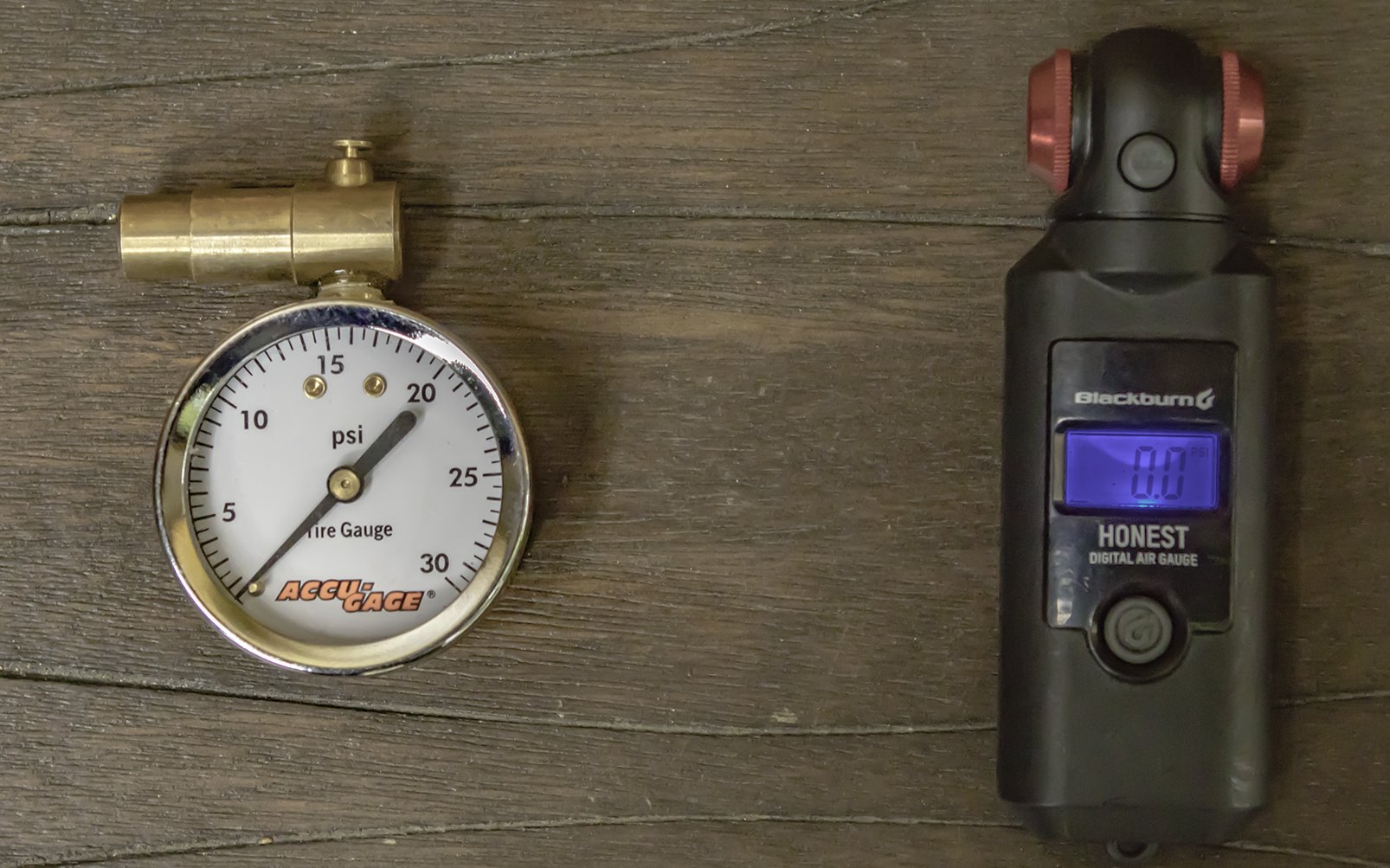
Mano a Mano
Tire Gauges - Blackburn Honest Digital Vs. Accu-Gage
I was feeling good on my bike and riding well in some situations last weekend, but when the speeds rose I was terrified and had to keep things reined in. We have been riding in ice, snow and rain recently and my tire pressure had been trending downward for improved grip. And I got a little lazy about checking, using the squeeze and bounce tests. It turns out that the 2.5/2.4 Minion combo I was running had dropped embarrassingly into the mid teens measured by PSI. Once pumped and checked by gauge to be back at my current big tire mid-winter preference of 20 front and 22 rear,* everything went back to normal.
*for most of the technical, generally low speed riding on the Shore this suits my 160 odd pounds just fine with 2.4 or larger rubber.
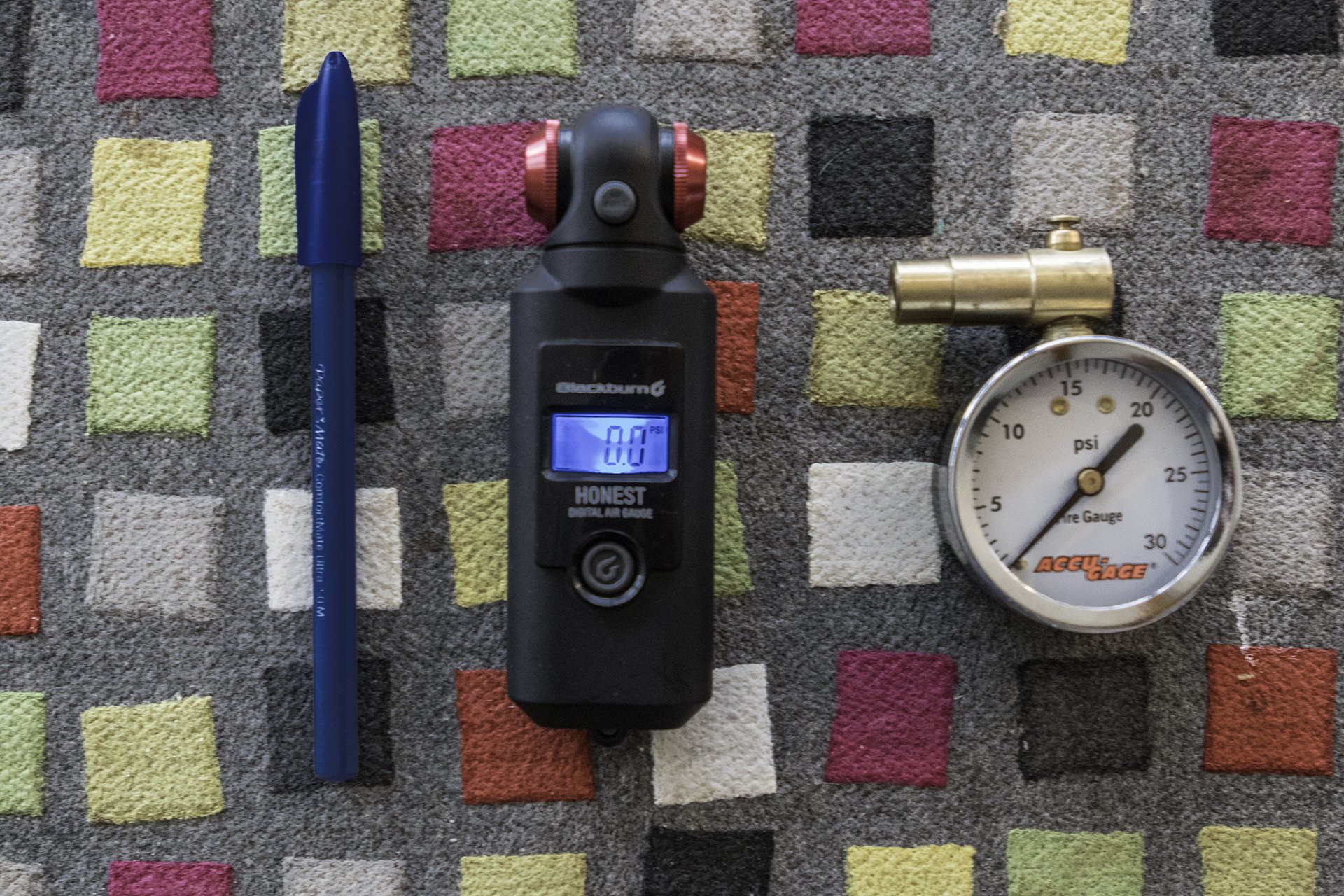
The Blackburn Honest Digital gauge (68 grams) is longer but thinner and much lighter, while the Accu-Gage is compact but hefty (159 grams).
One problem with the squeeze test is that you are most likely comparing to your own tires the last time you performed this operation; without reference it's about as accurate as Trump's assessment of Putin. In the era of skinnier, tubed-tires, being 4 PSI off in one direction or the other wasn't a huge deal. If you normally ran 30 you could probably survive on 34 and you may not have flatted riding 26, but that same margin from 22 (or less for plus or fat tires) could mess up your ride - or your brand new rim.
All this means getting an accurate pressure reading is more important now and, aside from occasional laziness lapses, I use one consistently.
This Mano a Mano pits the tech heads against the luddites, analog vs. digital, and old vs. new.
G.H. MEISER Accu-Gage 30 and 15
I can't remember where I first saw an Accu-Gage but I was drawn to it instantly. A large easy to read dial appeals to my inflexible retinas and given the choice between digital and analog I'll take the needle - unless there is some compelling reason not to.
Solid may have been my first thought when I pulled one of the two Accu-Gages out of the shipping box, which isn't surprising considering the brass head, which seems to account for most of the heft. It feels like a quality piece but at 159 grams, perhaps not one you'll want to take on most rides. That impression continues when the gauge is in use; the needle springs instantly to the reading with almost no flicker or bounce. The measurement stays until you hit the reset/bleed release at which point the needle returns to zero just as precisely.
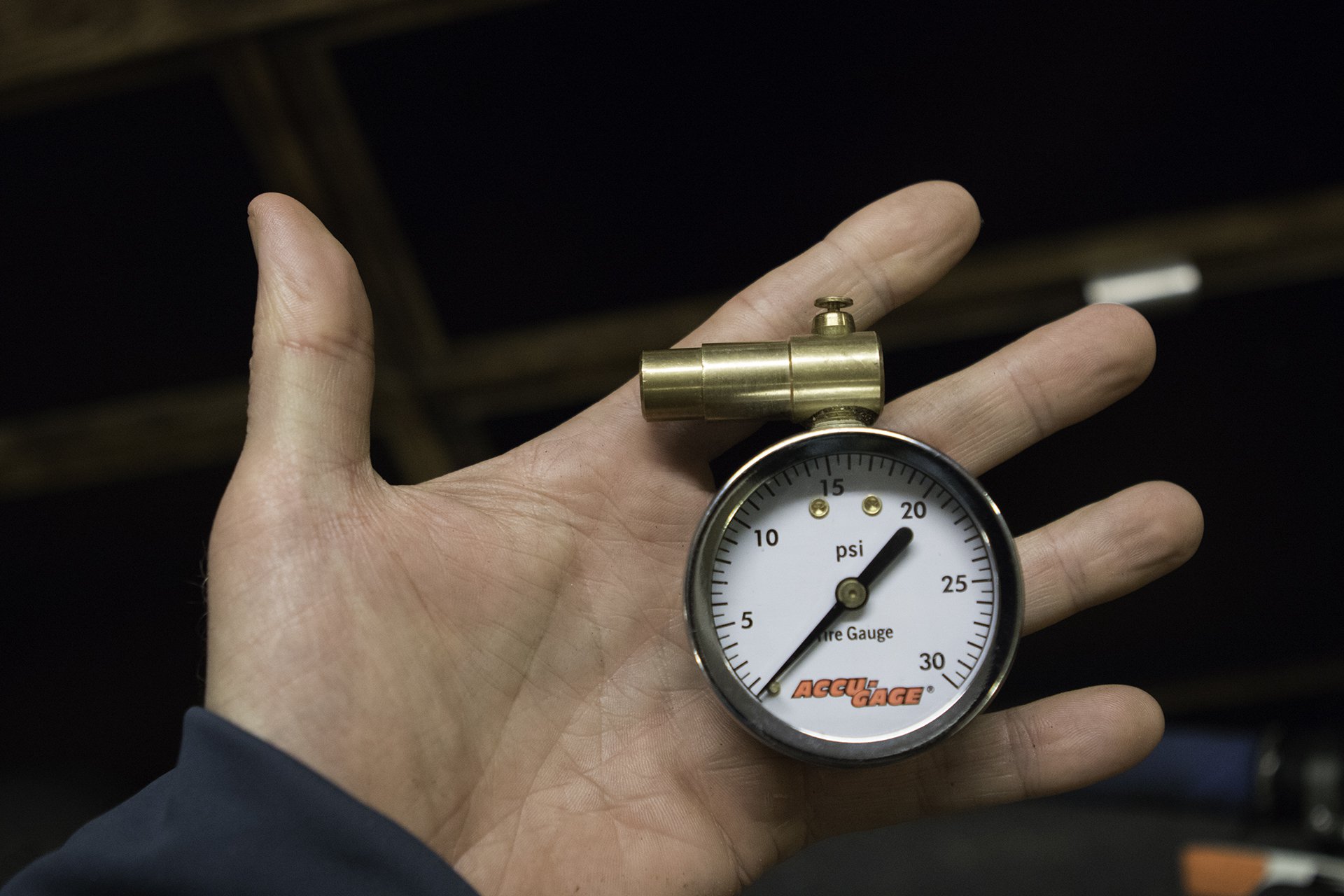
The palm-sized Accu-Gage can be used one handed effectively.
Floor pumps aren't often very accurate (both of mine were out by as much as 10%) but they are generally consistent. To inflate I go to a point above my desired pressure, with pump error in mind, and then bleed until I reach my goal. The head engages without losing much air at all and disengages with similar efficiency. Mounting and removing the gauge releases a volume of air so small, with a satisfying split-second 'pfft,' that it barely registers on the Accu-Gage.
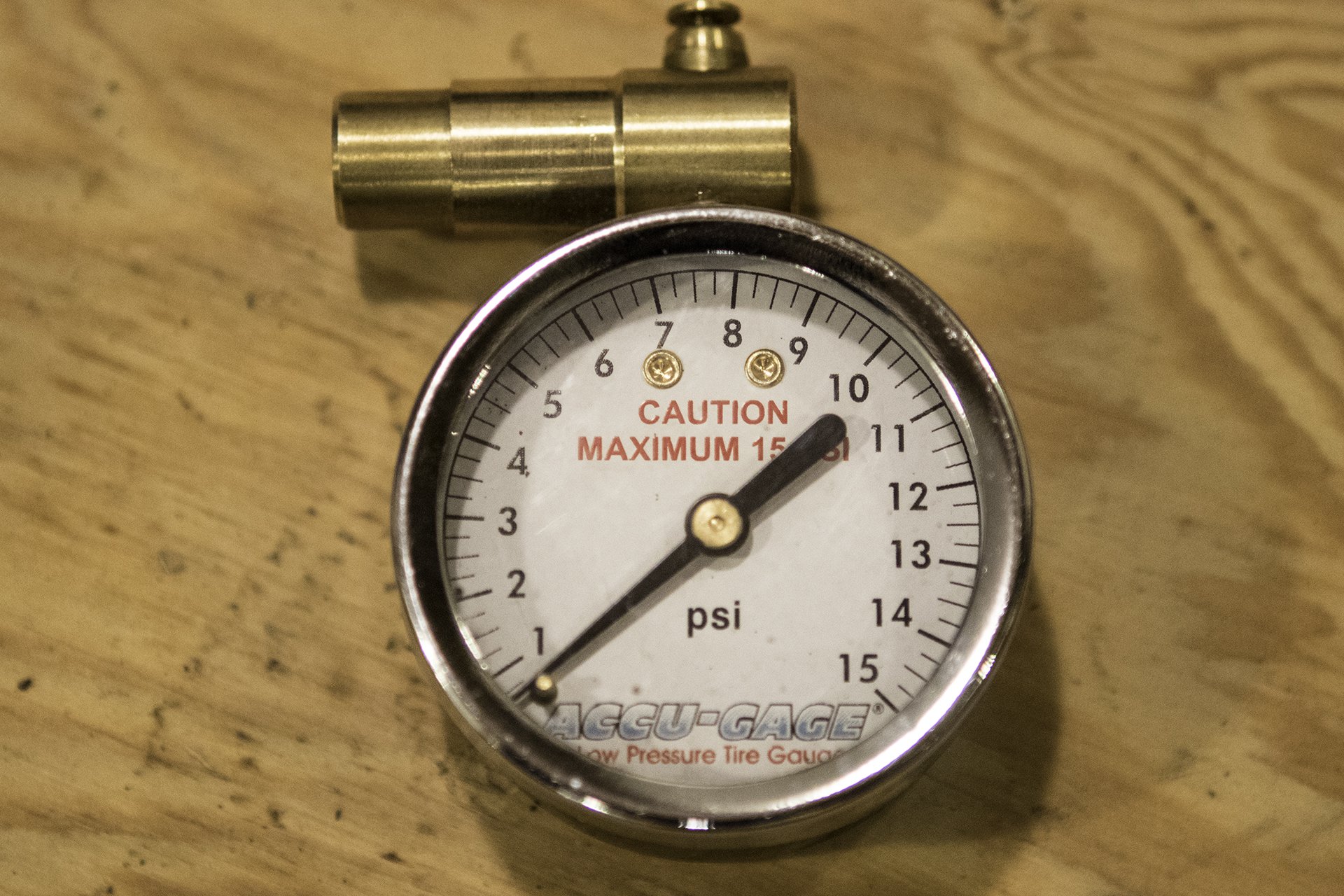
If you are exclusively a fat biker (no judgment!) you might consider the max 15 PSI version of the Accu-Gage for improved readability and precision. Accuracy is similar to the 30 PSI max version.
The dial allows you to see half PSI readings easily and even quarters well enough for the 30 PSI model, while the 15 PSI version allows you to determine when the needle is directly between the quarter PSI marks for an eighth of a PSI.
This device works so well it can be easily used with one hand without any measurable loss of air and it's a pleasure to use.
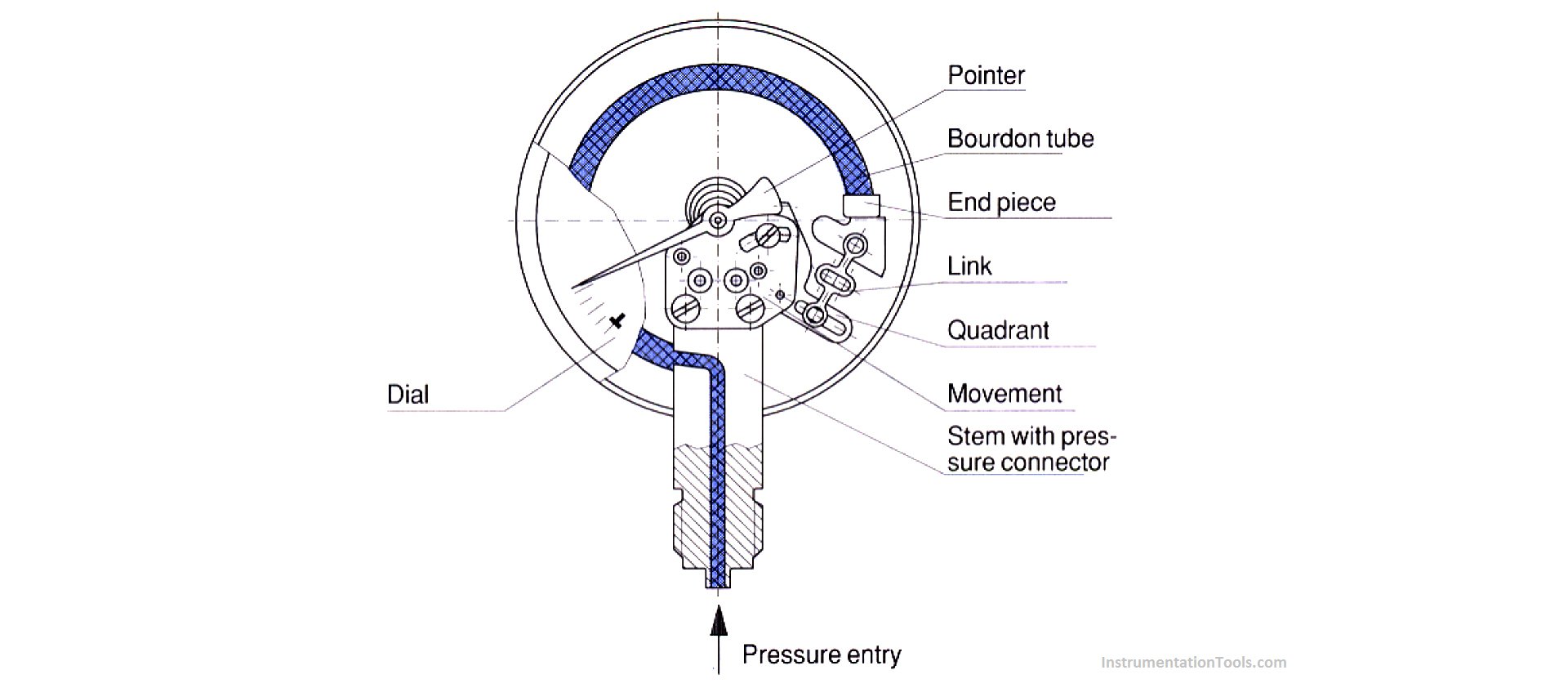
Most high quality analog pressure gauges use a Bourdon tube, which was almost certainly designed by Robbie Bourdon while recovering from an injury. In 1849. The Bourdon tube is largely unaffected by changes in atmospheric pressure and temperature and is both sensitive and highly accurate. Check the video below to see how it works. Skip to 3:07 to see the mechanism in action.
Blackburn Honest Digital Gauge
Blackburn wins the versatility challenge with ease by accepting both presta and schrader valves and measuring up to 150 PSI. The design is sleek and light and features a 180º rotating head and a valve that effectively releases air at a moderate pace . It also switches instantly from PSI to BAR with a tap of the on button and features an illuminated LED read out. The unit is powered by two CR2032 coin cell batteries and is said to be accurate within 1% of pressure.
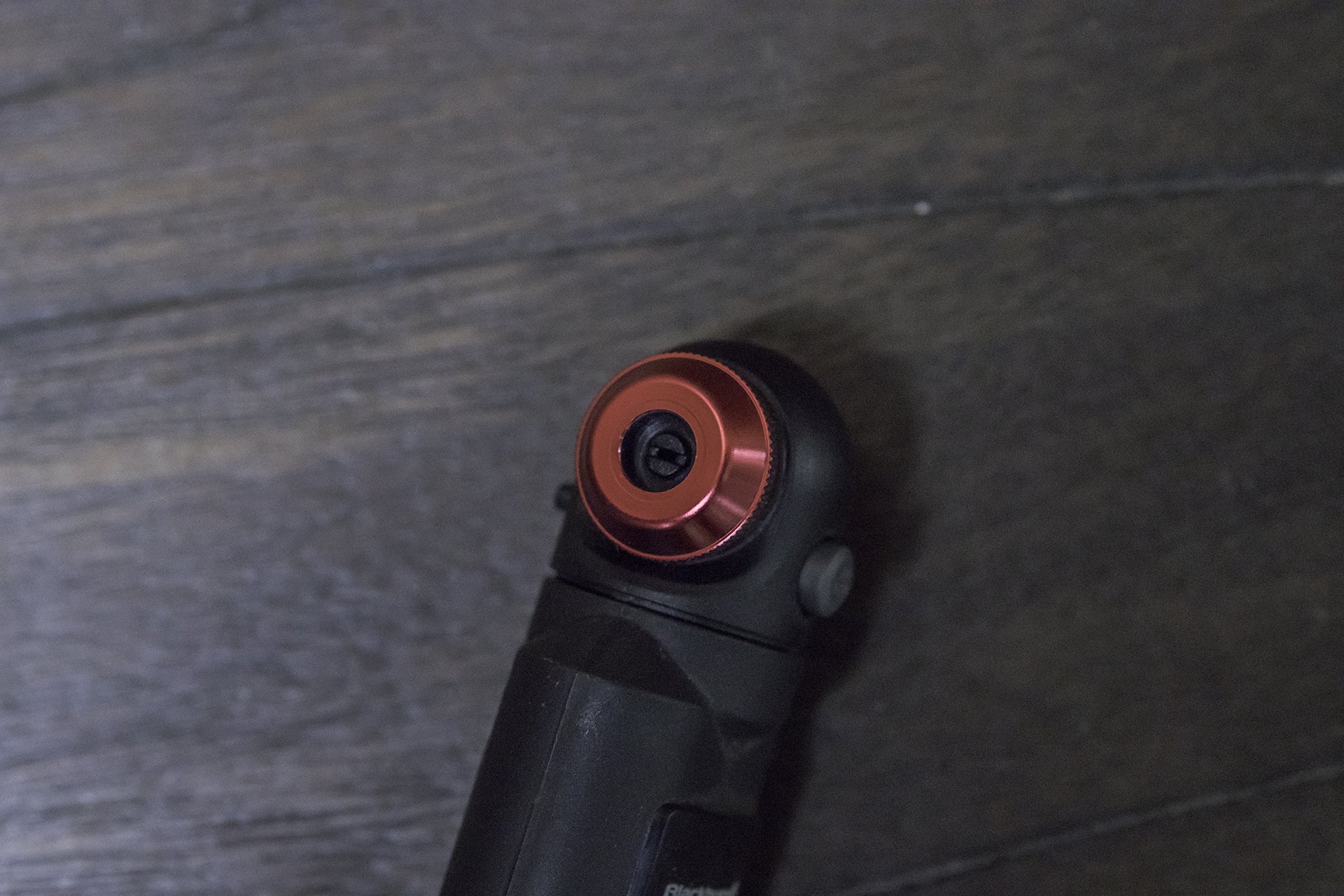
The schrader head doesn't get used around my house but it's nice to have. Other reviewers have indicated it works better than the presta. It should be useful for my truck though.
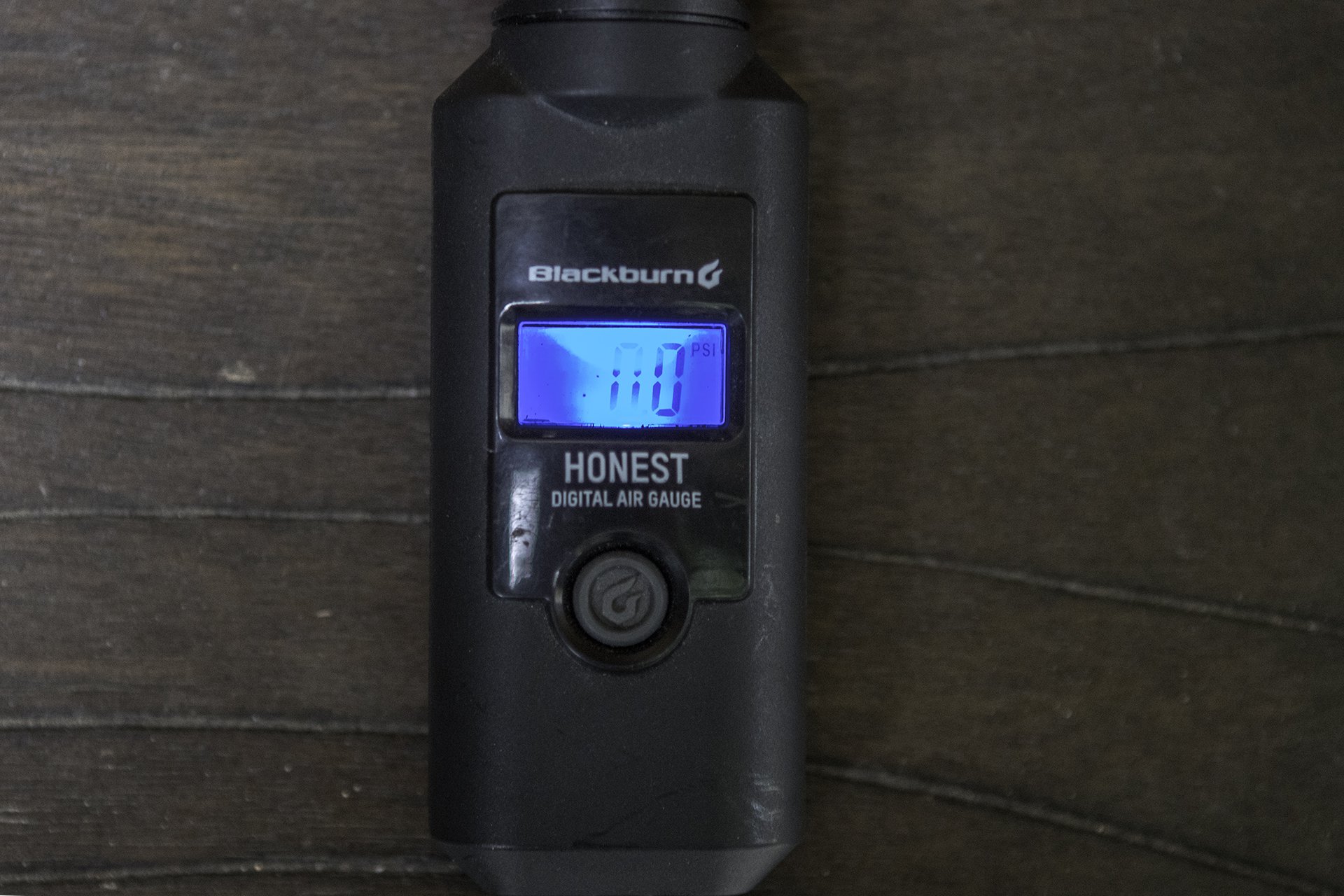
The gauge is an attractive blue and very easy to read. It is however more difficult to photograph.
At 68 grams, the compact shape easily fits in a pocket, bumbag or backpack and it retails for around 25 USD. All this info was great news, but using the product wasn't as tidy. I find it difficult to get a reading without accidentally bleeding a significant amount of air, both engaging and disengaging the unit, often forcing me to start again with the floor pump. Even once mounted the seal isn't satisfactory in my view and it takes a deft hand to get a reading without frustrating gasps from your presta.
One handed operating is even trickier. I eventually had good luck pushing the gage up on the presta with the valve in the high noon position. This is also an easy spot to get view the display. I also had an issue with batteries. Twice I've had the battery indicator suggest "Lob" long before it seemed to me there should have been any significant battery drain. Currently it unpredictably alternates between working fine and indicating low batteries - even at room temperature.
Verdict
For me this is an easy one. I don't carry a gauge on rides so I'm using it in my shop or at my truck before a ride, making portability a non-issue. I want a repeatable, reliable measurement that is easily performed, one-handed if possible. I don't require schrader capability, high pressure or a reading in BAR and if I can avoid batteries I'm happier for it. My preferences make Meiser's Accu-Gage an easy winner.
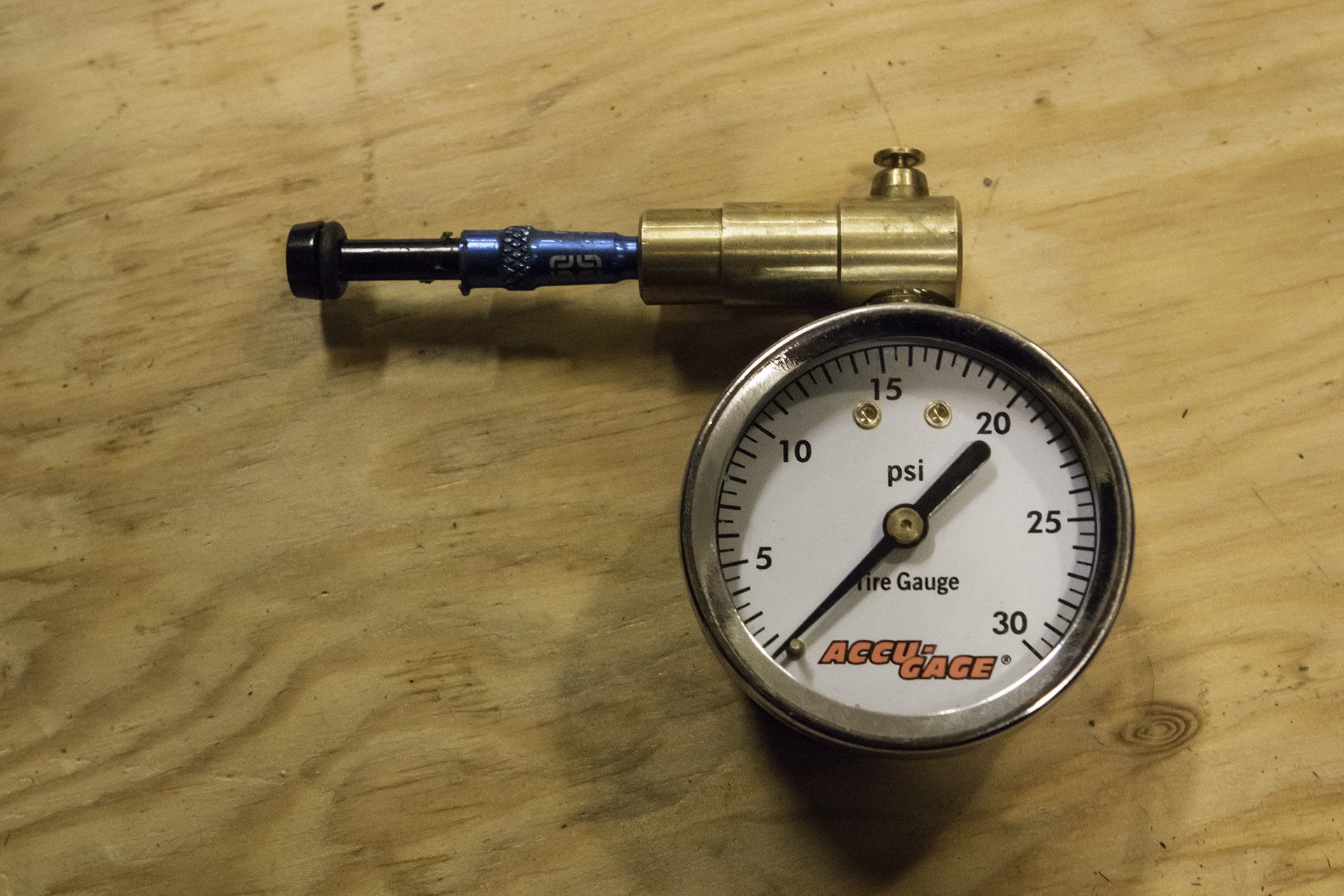
Meiser's large brass head allows your valve to be inserted to 20mm, giving an excellent seal without much pushing.
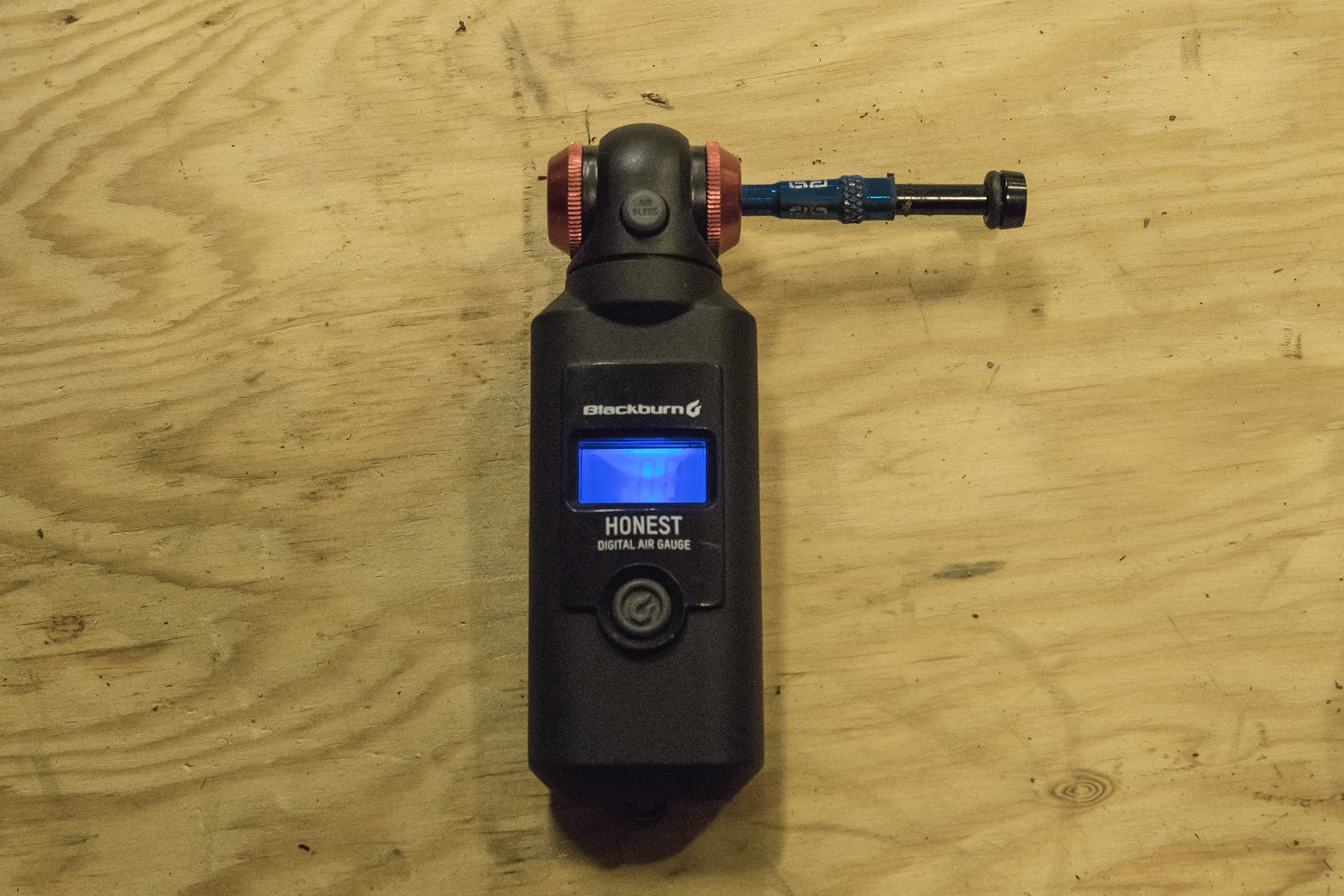
Blackburn's Honest Digital, because of its dual schrader/presta head, only allows 12mm of insertion meaning there is less seal overlap and more hand force is required to get a good reading. Pressure loss getting a reading can be a problem as well.
If your requirements are portability and adaptability as well as the ability to measure high pressures, and you can deal with a little inconvenience, then the Honest Digital Gauge may be for you.
Both are reasonably priced. You can pick up a Blackburn gauge for 25 USD while an Accu-Gage, in either 15, 30 or 60 PSI max will set you back 15 USD or 28 CAD on Amazon.
More on the Blackburn Honest Digital Gauge here and more on Accu-Gage here.







Comments
IslandLife
5 years, 2 months ago
Nice review... I've had a good experience so far with my Schwalbe Airmax Pro Digital Pressure Gauge. Relatively cheap for a digital gauge ($29 CAD), light (34g), ergonomic (the "squashed egg" shape is great in the hand, easy to grip and use one-handed), and can be used on both Presta and Schrader valves. Also available at your local MEC (trying my best to avoid Amazon these days...).
I have a similar story when I realized I needed a proper gauge after realizing my floor pump would typically read 5 to 10 psi too high! A couple rim dings later I bought this gauge and all has been well.
Reply
Pete Roggeman
5 years, 2 months ago
I used to use one of these, but then it died - new batteries did not help. I do not think it got doused in water, but a bit of time passed in between uses so I couldn't be sure. In any case, until then I was very happy with its performance and price at ~20 bucks. Currently using the SKS Airchecker and it's worked out well also.
Reply
dan_l
5 years, 2 months ago
Bourdon tube style gauges are what you want for many reasons when measuring tire pressure. This article hit on most of them. One of the negatives of the bourdon tubes are that if you drop them, they can be damaged and give you offset readings.
To eliminate the issue of clogging the gauges, fill the tires with the valve tip resting down. With good "race" sealant, you can clog the gauge in a single measurement. I have not found a way to get the gunk out of the accugauge, but I also didn't spend much time trying to repair it.
Reply
Heinous
5 years, 2 months ago
Dropping and other loss of calibration is an issue if you're race wrenching or travelling a lot. For that reason I've stuck with digital (Topeak Digital D2). The fact they're a little lighter is useful too - excess baggage is a pain in the arse.
The other feature I like with the D2 is it switches between PSI/BAR. Depending on the athletes I work with they can be very specific and I've never been able to consistently convert BAR in my head on the fly.
Reply
Cam McRae
5 years, 2 months ago
I've heard good things about the D2. Thanks for the tips.
Reply
Velocipedestrian
5 years, 2 months ago
Good timing Cam, I've recently built a new wider rimmed wheelset, and am finding it hard to balance grip vs pinch with the added volume.
I'd already decided on the accu-gague but have read they prefer to be used in the middle of the range, any trouble with your 60-70% of max use?
There is a 0-60psi version, but if the 30 can cope I'd rather have the finer increments.
Reply
grcgrc
5 years, 2 months ago
Any analogue gauge prefers to be used in the centre of its range. That is where it is most accurate.
That being said, as long as you are not working at the edge of its range the accuracy will be very good. Particularly for this application.
Reply
Cam McRae
5 years, 2 months ago
No issues thus far and that’s the range I’m in. Consistent and accurate.
Reply
AndrewR
5 years, 2 months ago
I typically run 22.5 front/ 24.5 rear in summer and 21 front/ 22.5 rear in late autumn/ winter/ early spring on Conti Der Baron Projekt 29 x 2.4 on We Are One Agent rims (30 mm inner width) and I have had no troubles with my 0-30 Accugauge using it for the past three years. Just faster and easier to use (see) than the multitude of digital gauges I have in my workshop/ travel bag (Schwalbe - excellent and small - lives in my guide pack; Topeak - pretty good; SKS Airchecker - pretty good but designed for right hand use only, annoying if you have to check pressures using your left hand). I am guessing that my pressures are slightly at the upper end of middle but as I never exceed 25 psi (and have a multitude of other gauges to use if I ever needed to) I did not see the need for greater than 30 psi. Hope that helps. Happy trails
Reply
Velocipedestrian
5 years, 2 months ago
Great, mind eased. 30psi it is.
Reply
Pete Roggeman
5 years, 2 months ago
One thing that people should be careful to note is that your air pressure is going to differ if you're measuring it inside and then take it out for winter riding. No matter what you do, make sure you measure under consistent conditions and factor in temperature (and altitude!) changes.
Reply
AndrewR
5 years, 2 months ago
Agreed air pressures done at the trail head (five minutes before the agreed ride start time) and tuned with my trusty (except for the gauge) and impossible to kill Axiom plastic track pump (I have Silca envy but this thing refuses to die).
Reply
Andy Eunson
5 years, 2 months ago
My Accuguage has become clogged with sealant. I think. Has anyone pulled one apart to clean it out or is there a cleaning fluid that would work?
Reply
JVP
5 years, 2 months ago
The very end of the brass nozzle unscrews easily. Just make sure to keep track of the order that the plastic and rubber parts go in, and which way they face. It's not all that intuitive.
Should be easy to clean if the valve is clogged. If you have sealant deeper into the tube, then you're probably due for a new gauge. I'd say these are far easier to clean than any digital gauge.
Reply
[user profile deleted]
5 years, 2 months ago
This comment has been removed.
Cam McRae
5 years, 2 months ago
Good question James. Further research needed!
Reply
Heinous
5 years, 2 months ago
I've worked with a range of pro race teams on road, mtb, cx. Road it's not something people worry about a lot outside of TT's (and most pumps get more accurate at higher pressure).
For CX (easily the most picky athletes, as they should be on low volume tyres atop carbon rims) there's a split of accu-gage's and digital gauges (Topeak DS is my go to), with some wrenches simply relying on the digital read of their handheld compressors/pumps. Mtb seems similar. As I mentioned above, the digital gauge's ability to rotate between PSI and BAR is handy on teams where athletes come from different parts of the world so have different measures.
Reply
Lynx .
5 years, 2 months ago
Very good question. From what I've seen in videos, a lot of them use the Topeak Digital one, I have one and it's worked well for years, but only does full PSI, so have to guess if you want in between - want 12.5 PSI, then take it to 13 and bleed it out till it falls just under and guess from there :-\
Reply
AndrewR
5 years, 2 months ago
Also designed for right handers. I have one, it does the job but as I experiment with 0.5 psi increments it has been relegated to the car.
Reply
Heinous
5 years, 2 months ago
The Topeak is rotatable for left or right hand. I'm a lefty myself.
Reply
AndrewR
5 years, 2 months ago
This comment has been removed.
Reed Holden
5 years, 2 months ago
I am amazed how many use a tire gauge. My pump may not be perfectly accurate but it is consistent. If you are constantly borowing pumps I get it but if that is the issue, but then why not spend $30 on your own pump. Can someone tell me why you all need to know your exact tire pressure? Why not just pump them up to what feels right and do that every time. In fact, don't you still have to do that even with the gauge? Pump them up to what feels right?
Reply
AndrewR
5 years, 2 months ago
It is well known that most people cannot feel to within a reasonably precise range. There are also variations for elevation and temperature. Also tyres lose air over a period of time depending on the case thickness, rim fit and other factors. Knowing what pressures work for one's riding and tyres means that they can be quickly checked before a ride and no time will be wasted during a ride wondering why the bike isn't performing as expected or stopping because of a flat that could have been avoided. Or riding like crap because there is too much pressure in the tyres (a common problem). A hand held gauge is less likely to get damaged in the long run than the gauge on a track pump and is well worth the small price.
Reply
mzro
4 years, 5 months ago
Blackburn digital gauge is plain awful in my experience. Bought it as I wanted to try digital gauges and deeply regret I did. I am not able to measure the pressure in tires of my 3 bikes (fat, 29+ plus trail bike and DH bike). The shaft is way too short, it just bleeds the air and not able to read the pressure. I also have a Mezzer Accu gauges 15 and 30 psi which are dead simple and reliable.
Reply
AndrewR
4 years, 5 months ago
@mzro I am coming up to my fourth year with the Schwalbe for the trail and the Accugauge for the work shop/ car.
Reply
Deniz Merdano
4 years, 5 months ago
Having used all of the mentioned gauges, I recommend the Shimano Pro gauge..
Smallest on the market. Reliable.
I also own and use the topeak regularly.
Reply
Eric Van Sickle
3 years, 7 months ago
Is there any way to fix an Accu Gauge? I stupidly forgot to take some air out of my rear tire after setting it up tubeless and checked the pressure with my gauge (Max. 30psi) and now I can’t get a reading?
Thanks and sorry for the old thread resurrection.
Reply
Please log in to leave a comment.